Question Number 101680 by john santu last updated on 04/Jul/20
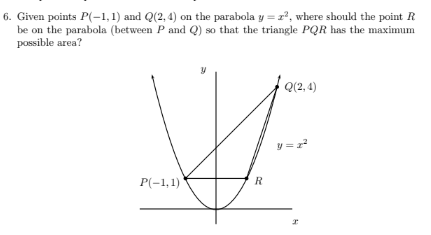
Answered by bemath last updated on 04/Jul/20
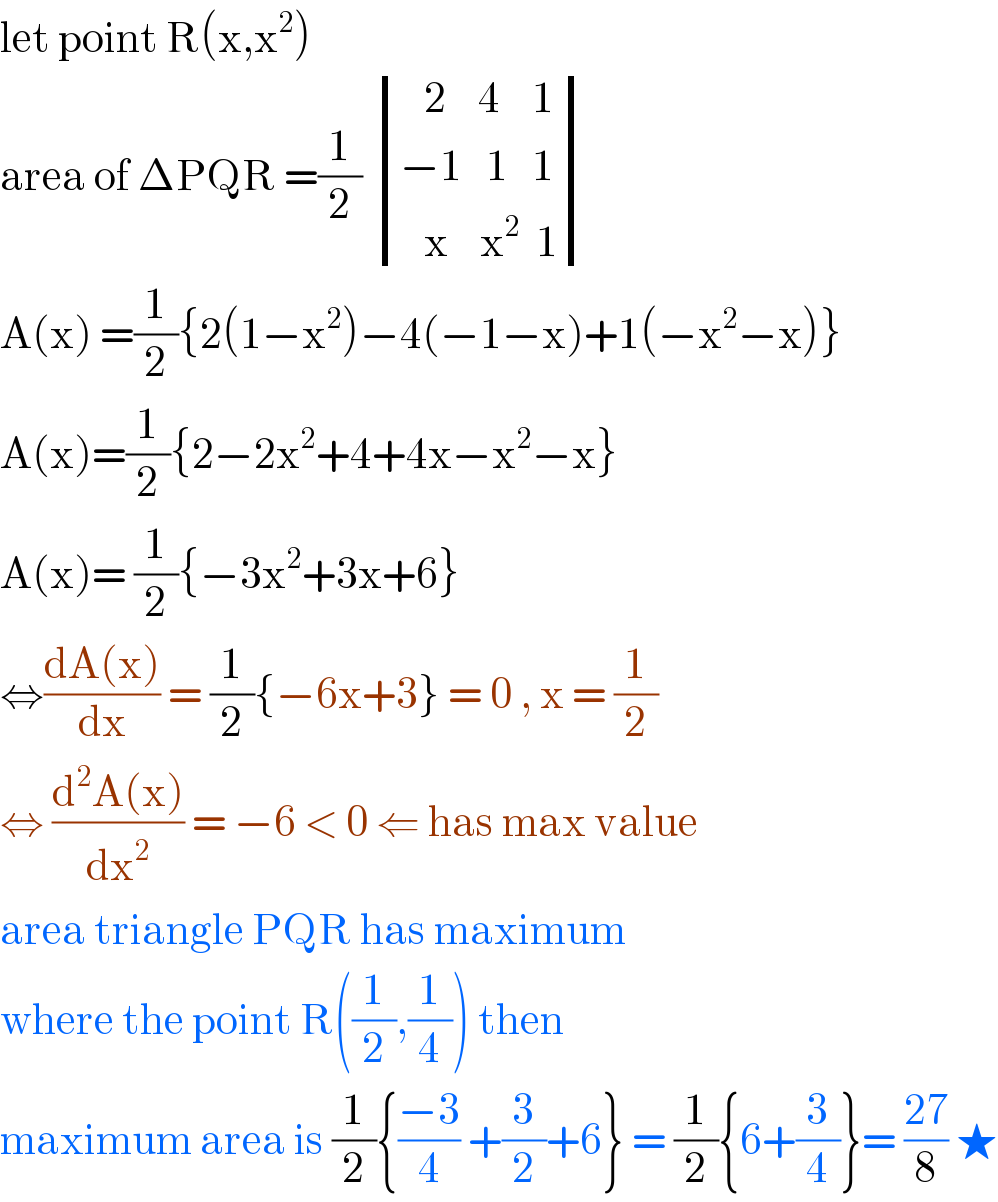
$$\mathrm{let}\:\mathrm{point}\:\mathrm{R}\left(\mathrm{x},\mathrm{x}^{\mathrm{2}} \right) \\ $$$$\mathrm{area}\:\mathrm{of}\:\Delta\mathrm{PQR}\:=\frac{\mathrm{1}}{\mathrm{2}}\:\begin{vmatrix}{\:\:\:\mathrm{2}\:\:\:\:\mathrm{4}\:\:\:\:\mathrm{1}}\\{−\mathrm{1}\:\:\:\mathrm{1}\:\:\:\mathrm{1}}\\{\:\:\:\mathrm{x}\:\:\:\:\mathrm{x}^{\mathrm{2}} \:\:\mathrm{1}}\end{vmatrix} \\ $$$$\mathrm{A}\left(\mathrm{x}\right)\:=\frac{\mathrm{1}}{\mathrm{2}}\left\{\mathrm{2}\left(\mathrm{1}−\mathrm{x}^{\mathrm{2}} \right)−\mathrm{4}\left(−\mathrm{1}−\mathrm{x}\right)+\mathrm{1}\left(−\mathrm{x}^{\mathrm{2}} −\mathrm{x}\right)\right\} \\ $$$$\mathrm{A}\left(\mathrm{x}\right)=\frac{\mathrm{1}}{\mathrm{2}}\left\{\mathrm{2}−\mathrm{2x}^{\mathrm{2}} +\mathrm{4}+\mathrm{4x}−\mathrm{x}^{\mathrm{2}} −\mathrm{x}\right\} \\ $$$$\mathrm{A}\left(\mathrm{x}\right)=\:\frac{\mathrm{1}}{\mathrm{2}}\left\{−\mathrm{3x}^{\mathrm{2}} +\mathrm{3x}+\mathrm{6}\right\} \\ $$$$\Leftrightarrow\frac{\mathrm{dA}\left(\mathrm{x}\right)}{\mathrm{dx}}\:=\:\frac{\mathrm{1}}{\mathrm{2}}\left\{−\mathrm{6x}+\mathrm{3}\right\}\:=\:\mathrm{0}\:,\:\mathrm{x}\:=\:\frac{\mathrm{1}}{\mathrm{2}} \\ $$$$\Leftrightarrow\:\frac{\mathrm{d}^{\mathrm{2}} \mathrm{A}\left(\mathrm{x}\right)}{\mathrm{dx}^{\mathrm{2}} }\:=\:−\mathrm{6}\:<\:\mathrm{0}\:\Leftarrow\:\mathrm{has}\:\mathrm{max}\:\mathrm{value} \\ $$$$\mathrm{area}\:\mathrm{triangle}\:\mathrm{PQR}\:\mathrm{has}\:\mathrm{maximum} \\ $$$$\mathrm{where}\:\mathrm{the}\:\mathrm{point}\:\mathrm{R}\left(\frac{\mathrm{1}}{\mathrm{2}},\frac{\mathrm{1}}{\mathrm{4}}\right)\:\mathrm{then} \\ $$$$\mathrm{maximum}\:\mathrm{area}\:\mathrm{is}\:\frac{\mathrm{1}}{\mathrm{2}}\left\{\frac{−\mathrm{3}}{\mathrm{4}}\:+\frac{\mathrm{3}}{\mathrm{2}}+\mathrm{6}\right\}\:=\:\frac{\mathrm{1}}{\mathrm{2}}\left\{\mathrm{6}+\frac{\mathrm{3}}{\mathrm{4}}\right\}=\:\frac{\mathrm{27}}{\mathrm{8}}\:\bigstar \\ $$
Commented by john santu last updated on 04/Jul/20

$${correct}\:. \\ $$
Answered by mr W last updated on 04/Jul/20
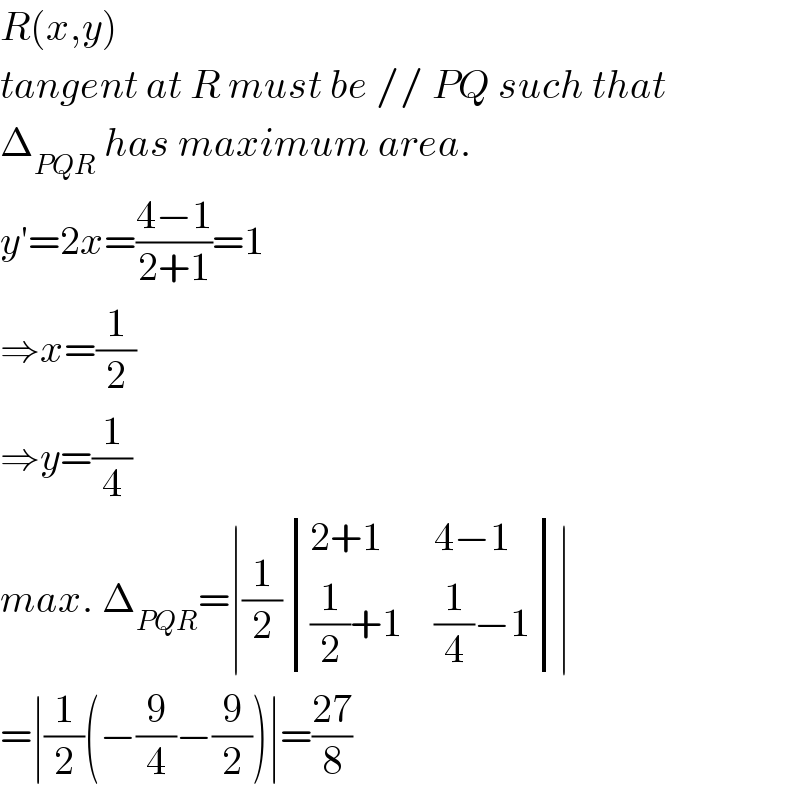
$${R}\left({x},{y}\right) \\ $$$${tangent}\:{at}\:{R}\:{must}\:{be}\://\:{PQ}\:{such}\:{that} \\ $$$$\Delta_{{PQR}} \:{has}\:{maximum}\:{area}. \\ $$$${y}'=\mathrm{2}{x}=\frac{\mathrm{4}−\mathrm{1}}{\mathrm{2}+\mathrm{1}}=\mathrm{1} \\ $$$$\Rightarrow{x}=\frac{\mathrm{1}}{\mathrm{2}} \\ $$$$\Rightarrow{y}=\frac{\mathrm{1}}{\mathrm{4}} \\ $$$${max}.\:\Delta_{{PQR}} =\mid\frac{\mathrm{1}}{\mathrm{2}}\begin{vmatrix}{\mathrm{2}+\mathrm{1}}&{\mathrm{4}−\mathrm{1}}\\{\frac{\mathrm{1}}{\mathrm{2}}+\mathrm{1}}&{\frac{\mathrm{1}}{\mathrm{4}}−\mathrm{1}}\end{vmatrix}\mid \\ $$$$=\mid\frac{\mathrm{1}}{\mathrm{2}}\left(−\frac{\mathrm{9}}{\mathrm{4}}−\frac{\mathrm{9}}{\mathrm{2}}\right)\mid=\frac{\mathrm{27}}{\mathrm{8}} \\ $$
Commented by bemath last updated on 04/Jul/20

$$\mathrm{sir}\:\mathrm{how}\:\mathrm{to}\:\mathrm{proof}\:\mathrm{tangent}\:\mathrm{at}\:\mathrm{R}\: \\ $$$$\mathrm{must}\:\mathrm{be}\:\mathrm{paralell}\:\mathrm{to}\:\mathrm{PQ}? \\ $$
Commented by mr W last updated on 04/Jul/20
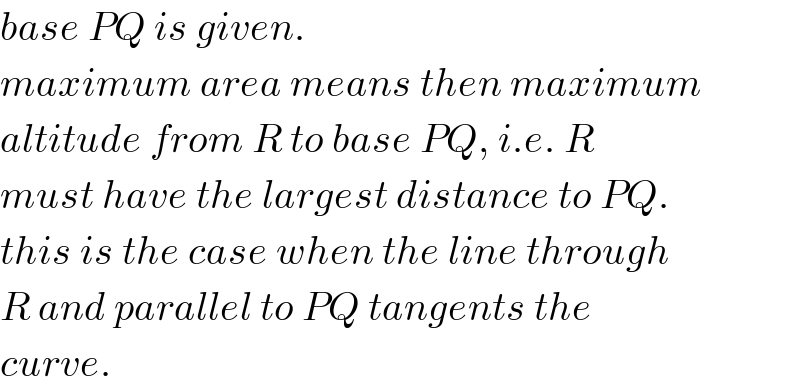
$${base}\:{PQ}\:{is}\:{given}. \\ $$$${maximum}\:{area}\:{means}\:{then}\:{maximum} \\ $$$${altitude}\:{from}\:{R}\:{to}\:{base}\:{PQ},\:{i}.{e}.\:{R} \\ $$$${must}\:{have}\:{the}\:{largest}\:{distance}\:{to}\:{PQ}. \\ $$$${this}\:{is}\:{the}\:{case}\:{when}\:{the}\:{line}\:{through} \\ $$$${R}\:{and}\:{parallel}\:{to}\:{PQ}\:{tangents}\:{the} \\ $$$${curve}. \\ $$
Commented by mr W last updated on 04/Jul/20
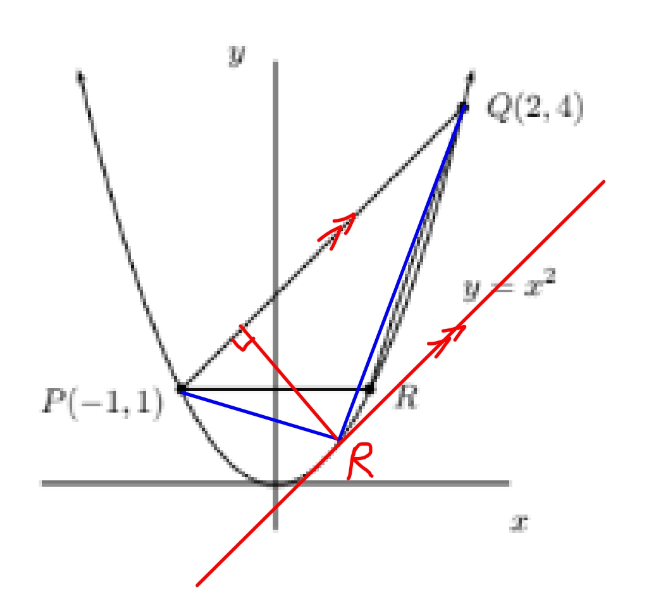
Commented by bemath last updated on 04/Jul/20

$$\mathrm{ok}\:\mathrm{sir}.\:\mathrm{i}\:\mathrm{understand}.\:\mathrm{thank}\:\mathrm{you} \\ $$
Commented by john santu last updated on 04/Jul/20

$${great} \\ $$
